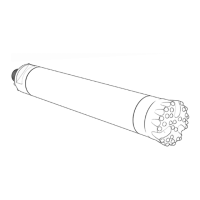3
Introduction
General info
The down-the-hole hammer is a percussion hammer drill. The
hammer works down the hole at the end of the drill string, where
the impact piston strikes the drill bit directly.
Compressed air is led to the hammer via the rotation spindle and
drill pipes. Exhaust air from the hammer is discharged through
holes in the drill bit and used to flush clean the drill hole. Rotation
is provided by a rotation unit on the feed beam and transmitted to
the hammer via the drill pipes. The drill pipes are threaded so that
the drill string can be extended as the hole becomes deeper. Feed
force is also transmitted to the hammer via the rotation unit and
drill pipes.
How the hammer works
The Secoroc COP M6, M7 M8 down-the-hole hammers and drill
bits operate at the bottom of the hole as one unit.
A driver chuck (2) threads into the front end of the casing (7). The
splined union between the driver chuck and drill bit (1) transmits
rotation to the drill bit. The front end of the driver chuck trans
-
mits feed force to the drill bit. The split stop ring (3) limits axial
movement of the drill bit. The check valve (8) prevents water from
entering the hammer through the drill bit when the compressed
air supply is shut off.
When feed force is applied, the drill bit is pushed into the ham
-
mer and pressed against the front of the driver chuck. The impact
piston (5) strikes the shank of the drill bit directly. The passage
of compressed air through the hammer is directed by the piston,
control tube (6) and bit bushing (4), which all have regulating
ducts. A built-in damping chamber cushions the piston return
stroke and increases the impact frequency.
After the compressed air has imparted most of its pressure en
-
ergy to the piston, it is led as exhaust air through airchannels on
the splines of drill bit and chuck. The exhaust air then emerges as
flushing air through holes in the drill bit head. This gives efficient
transportation of cuttings out of the drill hole
When the hammer is lifted off the bottom of the hole, the piston
drops into the air blowing position. This disengages percussion
and gives air blowing only, that is, a large volume of air flows
straight through the hammer and drill bit. During drilling, air
blowing starts if the drill bit loses contact with the bottom of the
hole. The hammer starts operating again as soon as the bit is
pressed back against the driver chuck. Air blowing is used when
powerful flushing of the drill hole is required, and in certain dif
-
ficult drilling conditions.
Friction between the drill pipes and the hole wall can sometimes
reduce the penetration rate. This can often be counteracted by
increasing the air pressure to give more impact power and faster
penetration.
8
7
6
5
4
3
2
1

